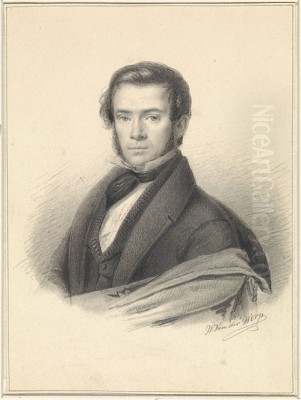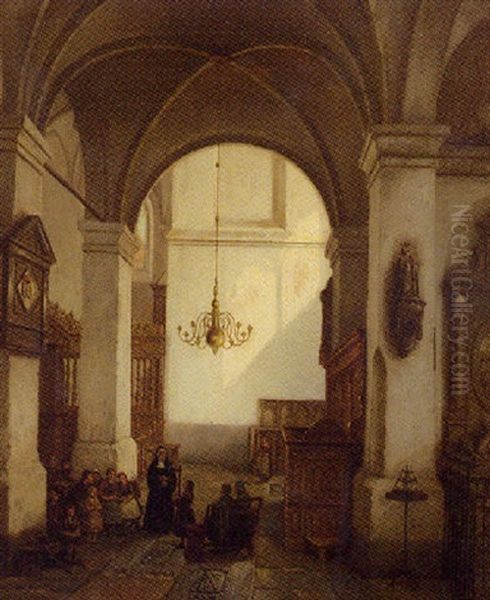
George Gillis van Haanen (1807-1879) stands as a notable figure in the rich tapestry of 19th-century Dutch painting. Born in Utrecht, a city with a long artistic heritage, Van Haanen carved a niche for himself through his meticulous depictions of landscapes, bustling genre scenes, and evocative interiors, often distinguished by a remarkable sensitivity to light and atmosphere. While perhaps not as globally renowned as some of his Dutch contemporaries or the later Hague School masters, his work embodies the technical skill and thematic concerns prevalent in Dutch art during the Romantic and early Realist periods. His life and art offer a fascinating window into the artistic milieu of the Netherlands as it navigated its legacy and embraced new directions.
An Artistic Dynasty: The Van Haanen Family
George Gillis van Haanen was born into an environment steeped in art. His father, Casparis van Haanen (1778-1849), was not only a painter but also a skilled paper-cutter (papiersnijder) and an avid collector, particularly of prints by Old Masters. This familial immersion provided George Gillis and his siblings with an invaluable early education and fostered a deep appreciation for artistic creation. The Van Haanen household was, in essence, a small artistic hub.
The talent was not confined to George Gillis. Several of his siblings also pursued artistic careers, making the Van Haanens a significant artistic family of their time. His brother, Remigius Adrianus van Haanen (1812-1894), became a well-regarded landscape painter, known especially for his winter scenes and achieving considerable success internationally, particularly in Austria and Germany. His sisters, Adriana Johanna van Haanen (1814-1895), specialized primarily in flower painting and still lifes, while Elisabeth Alida van Haanen (1809-1845) focused on genre scenes and interiors. This shared vocation undoubtedly created a supportive, albeit potentially competitive, environment that spurred their individual developments.
Formative Years and Academic Recognition

George Gillis received his initial artistic instruction directly from his father, Casparis, learning the fundamentals of drawing and painting within the family home. He further honed his skills by studying at the city academy in Utrecht (Stadsakademie voor Teeken- en Bouwkunde). During his time there, he is believed to have received guidance from artists such as the animal and landscape painter Jan van Ravenswaay (1789-1869), known for his pastoral scenes often featuring cattle. This formal training supplemented the practical knowledge gained from his father and exposure to the family collection.
Van Haanen's burgeoning talent gained wider recognition, culminating in his election as a member of the prestigious Royal Academy of Arts (Koninklijke Academie van Beeldende Kunsten) in Amsterdam in 1835. Membership in such an institution was a significant mark of esteem, placing him firmly within the established art world of the Netherlands. It provided opportunities for exhibition, networking with fellow artists, and access to patrons. This academic validation underscored the technical proficiency and artistic merit already evident in his work.
The Essence of Van Haanen's Style: Light, Detail, and Atmosphere
George Gillis van Haanen's artistic style is characterized by a meticulous attention to detail, reminiscent of the Dutch 'fijnschilders' (fine painters) of the 17th century, such as Gerrit Dou (1613-1675) and Gabriël Metsu (1629-1667). He rendered textures, objects, and figures with painstaking care, creating scenes that invite close inspection. This detailed realism was coupled with a profound understanding and skillful manipulation of light.
His handling of light is perhaps one of the most distinctive features of his oeuvre. Van Haanen masterfully depicted various lighting conditions, from the clear light of day illuminating a busy market square to the soft, diffused light filtering through a church window, and most notably, the warm, intimate glow of candlelight or lamplight in interior scenes. This ability to capture the subtle nuances of light and shadow (chiaroscuro) imbued his paintings with a palpable atmosphere, often evoking a sense of warmth, intimacy, or quiet contemplation. His approach combined the precision of Realism with the atmospheric concerns often found in Romanticism. While contemporaries like Andreas Schelfhout (1787-1870) excelled in luminous Romantic landscapes, Van Haanen brought a similar sensitivity to light into his genre and interior subjects.
Capturing Daily Life: Genre Scenes and Marketplaces
Van Haanen excelled in the depiction of genre scenes – snapshots of everyday life that were popular among Dutch audiences in the 19th century, echoing the traditions of the Golden Age. He was particularly renowned for his lively and detailed market scenes. Works like his celebrated Hollandsche Markt (Dutch Market) exemplify this aspect of his art. These paintings typically teem with activity: vendors display their wares, shoppers haggle and converse, figures move through crowded squares often framed by characteristic Dutch architecture.
In these market scenes, Van Haanen demonstrated his skill in composing complex multi-figure arrangements and his keen eye for anecdotal detail. He captured the social fabric and commercial energy of urban life in the Netherlands. His approach can be compared to other painters of urban scenes, such as Cornelis Springer (1817-1891), who specialized in meticulously rendered cityscapes, though Van Haanen often focused more intensely on the human activity within the setting. The popularity of these works reflected a contemporary interest in national identity and the familiar rhythms of local life.
Intimate Interiors: Homes, Schools, and Churches
Beyond the bustling public squares, Van Haanen frequently turned his attention to interior spaces, rendering them with the same care for detail and light. He painted domestic interiors, workshops, church interiors, and notably, school scenes. His painting Night School offers a fascinating glimpse into 19th-century education, depicting students gathered under artificial light, absorbed in their lessons. Such works carry a social dimension, documenting aspects of contemporary life and institutions.
His church interiors, like Church Interior, showcase his ability to convey the scale and solemnity of sacred spaces, often focusing on the play of light through stained glass or illuminating architectural features. In this, his work resonates with that of Johannes Bosboom (1817-1891), a contemporary renowned for his atmospheric church interiors, though Bosboom often employed a broader, more suggestive technique, particularly later in his career associated with the Hague School. Van Haanen's interiors, whether secular or religious, are typically characterized by their carefully constructed perspective and the creation of a contained, often intimate, atmosphere.
Mastery of Nocturnes and Candlelight
A particular forte of George Gillis van Haanen was his depiction of nocturnal scenes, especially those illuminated by candlelight or lamplight. This sub-genre required considerable technical skill to convincingly render the effects of artificial light – the deep shadows, the warm highlights on faces and objects, the soft gradations of tone, and the overall intimate or sometimes mysterious mood. His candlelit interiors, market stalls operating after dark, or figures seen through windows at night are among his most evocative works.
In his focus on artificial light effects, Van Haanen can be seen as an heir to 17th-century specialists like Godfried Schalcken (1643-1706). He also shared this interest with contemporaries, most notably Petrus van Schendel (1806-1870), a Belgian-Dutch painter who built his reputation almost entirely on his virtuosic candlelit market scenes and interiors. While both artists explored similar themes, their handling could differ; Van Haanen often maintained a slightly crisper detail throughout the composition compared to Van Schendel's sometimes softer focus. These nocturnal scenes were highly popular with collectors, admired for their technical brilliance and romantic ambiance.
Journeys and Artistic Exchange: Van Haanen Abroad
Like many artists of his time, George Gillis van Haanen did not confine his activities solely to the Netherlands. Travel was essential for broadening artistic horizons, finding new subjects, and tapping into different markets and patronage networks. Van Haanen is known to have traveled and worked in various cities outside his homeland. Records indicate periods spent in Mainz and Cologne in Germany, Antwerp in Belgium, and Vienna in Austria.
These journeys exposed him to different artistic currents, such as the Biedermeier style prevalent in Germany and Austria, which emphasized domesticity, sentiment, and detailed realism – aspects that resonated with his own inclinations. Working abroad also allowed him to exhibit and sell his works to an international audience. His brother, Remigius Adrianus van Haanen, was particularly successful in establishing himself internationally, spending much of his career in Vienna and building extensive networks. While perhaps less peripatetic than Remigius, George Gillis's travels nonetheless enriched his experience and contributed to the dissemination of his work beyond Dutch borders, reflecting the increasing interconnectedness of the European art world in the 19th century. Other Dutch artists like the celebrated landscape painter Barend Cornelis Koekkoek (1803-1862) also spent significant time working in Germany, highlighting this trend.
Van Haanen and His Contemporaries: A Network of Influence
George Gillis van Haanen operated within a vibrant Dutch art scene. His primary influences stemmed from his family, particularly his father Casparis and his artist siblings Adriana Johanna, Elisabeth Alida, and Remigius Adrianus. His training under Jan van Ravenswaay connected him to the tradition of Dutch animal and landscape painting.
His work exists alongside that of major figures in Dutch Romantic and Realist painting. He shared the landscape interest of Andreas Schelfhout and B.C. Koekkoek, though his focus often shifted more towards genre elements within those landscapes or cityscapes. His detailed urban views find parallels in the work of Cornelis Springer. His church interiors can be compared to those of Johannes Bosboom, and his genre scenes relate to the broader European interest in everyday life, depicted by artists like David Bles (1821-1899) in the Netherlands. His specialization in night scenes links him directly to Petrus van Schendel.
While distinct from the later Hague School painters like Jozef Israëls (1824-1911), Anton Mauve (1838-1888), or Jacob Maris (1837-1899), who generally favoured looser brushwork and a greater emphasis on capturing fleeting atmospheric effects ('plein air' sensibility), Van Haanen represents an important phase in 19th-century Dutch art that valued meticulous craftsmanship, narrative detail, and the continuation of themes popular since the Golden Age, albeit infused with 19th-century sensibilities. His contemporaries included figures like Wijnand Nuijen (1813-1839), a highly talented Romantic painter whose early death cut short a promising career.
Legacy and Appreciation
George Gillis van Haanen died in 1879, leaving behind a substantial body of work characterized by technical refinement and appealing subject matter. During his lifetime, his paintings were exhibited in the Netherlands and likely abroad, finding favour with middle-class collectors who appreciated his detailed realism, familiar scenes, and mastery of light effects, particularly in his sought-after candlelit pictures. His membership in the Amsterdam Royal Academy attests to the respect he commanded within the official art establishment.
Today, his work is represented in various public collections, including Dutch museums like the Centraal Museum in Utrecht and potentially the Rijksmuseum in Amsterdam, as well as appearing on the art market. While the later innovations of the Hague School and subsequent modernist movements may have overshadowed painters of Van Haanen's generation in broader art historical narratives, his contribution remains significant. He stands as a skilled exponent of Dutch Romantic Realism, a master of intricate detail and evocative lighting, and a chronicler of the everyday life and specific atmospheres of his time. For those who appreciate meticulous technique, atmospheric genre painting, and the enduring traditions of Dutch art, the work of George Gillis van Haanen continues to hold considerable charm and historical interest. He successfully navigated the artistic currents of his era, creating a distinctive oeuvre that reflects both his personal talent and the cultural context of 19th-century Holland.